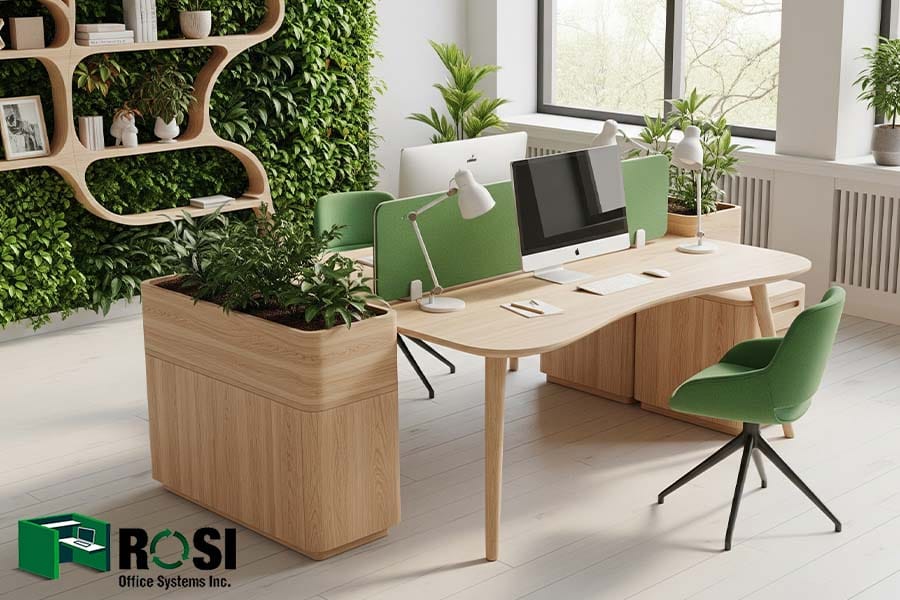
In recent years, people’s desire to bring nature back into their interiors has become one of the most important office design trends.
From home offices to modern workplaces, everyone is looking for ways to bring the calming feel of nature back into their spaces.
If you are one of these people, then “biophilic furniture” is exactly what you need.
But what is biophilic furniture?
Biophilic furniture refers to pieces designed to connect people with nature through natural materials, organic shapes, and greenery.
In 2026, it’s a key interior trend promoting well-being, sustainability, and calm in homes and workspaces.
It blends function with nature-inspired aesthetics for healthier environments.
In 2026, this style of design will have found a vital place in architecture and interior design as a response to the spiritual, environmental, and functional needs of humans.
In this comprehensive guide, we explain thoroughly what biophilic furniture is, why it holds a special place in the future of interior design, what features distinguish it from other styles, and how you can incorporate it into your living or working space, even on a limited budget.
What is Biophilia?
Biophilia means “the inherent and innate connection of humans with nature,” a concept first proposed by people such as E.O. Wilson.
He believed that humans are genetically inclined to be close to nature because they have lived in natural environments for thousands of years.
The biophilia hypothesis states that natural environments have a direct impact on human mental health, focus, and sense of well-being.
When this theory is applied to furniture design, the result is pieces that are not only functional but also reduce stress and promote relaxation by instilling a sense of nature.
This trend has now emerged in interior design and architecture in the form of “biophilic furniture and design.”
Core Principles of Biophilic Furniture Design
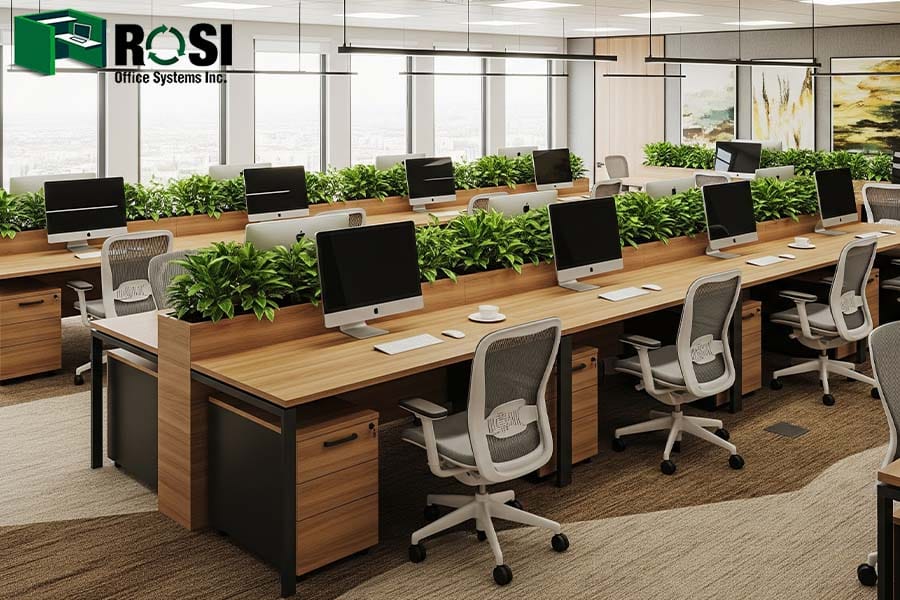
Biophilic design is based on three key principles, all of which seek to create a deeper connection between humans and nature in built spaces.
The first principle is Direct Nature, which refers to the direct use of natural elements in design.
The second principle, Indirect Nature, deals with the indirect use of symbols and signs from nature in design.
The third principle, Space and Place Conditions, deals with creating spaces that evoke feelings of safety, curiosity, and connection in people.
As a key component of any space, furniture can directly embody these principles: the use of natural wood, nature-inspired textures, organic forms, and even the integration of live plants into the structure of a chair or table.
All of this makes the human experience of the space not only functional, but also relaxing and alive.
You Might Also Enjoy: Friant Office Furniture: 2026 Review, Pros and Cons
How to Add Biophilic Touches to Your Furniture
Biophilic design is “the mapping of the entire building with nature in mind,” and biophilic furniture is “specific pieces of that map” that tangibly bring nature into the space.
Biophilic furniture, rooted in humans’ deep connection to nature, creates a relaxing and sensory experience in the space by combining natural materials, organic forms, and inspiration from the textures and colors of the natural environment.
1. Natural Materials at its Core
The use of materials such as reclaimed wood, natural edges, and sustainably sourced woods brings warm texture and unique grain to the space.
Stone and clay, with their tactile surfaces and earthy tones, add a sense of grounding and stability to the space, while bamboo, as a lightweight, durable, and renewable material, offers woven, natural textures.
Cork is also known as a renewable, antibacterial, and sound-absorbing material.
Also, natural fabrics such as linen, wool, hemp, and organic cotton in furniture upholstery enhance comfort, breathability, and a sense of naturalness.
2. Organic Shapes and Forms
In biophilic design, forms are often composed of curved lines and soft edges that reflect natural shapes.
The principles of biomimicry (taking inspiration from nature) are also seen in biophilic furniture design.
For example, leaf-shaped tables or legs with a branch-like structure which are reminiscent of natural forms and evoke a sense of familiarity with nature.
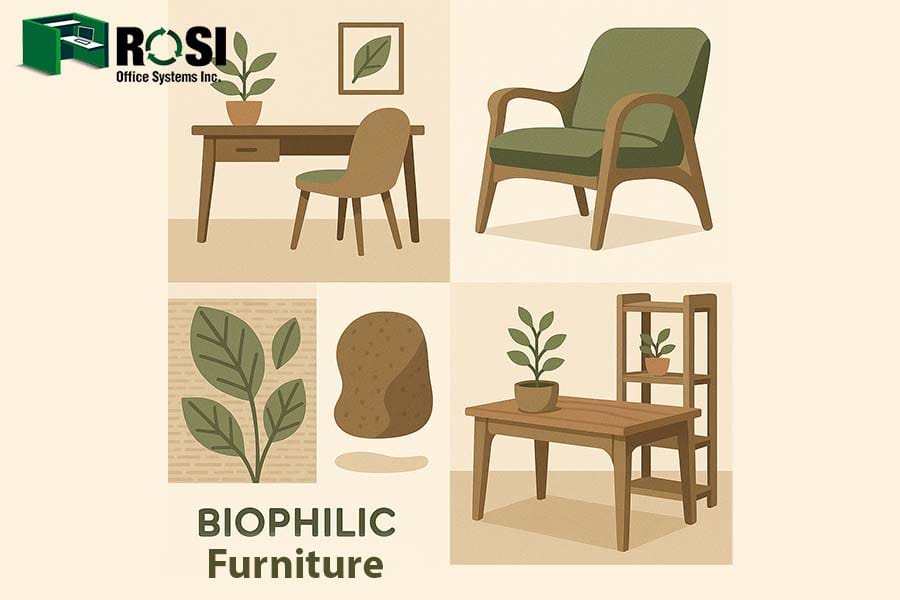
3. Nature-Inspired Colors and Textures
Colors with an earthy palette, such as natural greens, soothing blues, sandy nudes, and deep browns, are used in biophilic furniture to evoke a sense of being in nature.
Tactile textures such as woven fibers, raw wood, and natural stone surfaces also enhance the sensory experience of the space.
Nature-inspired patterns such as leaf designs, wood grains, or fractal patterns create a visual connection to natural environments.
4. Integration of Living Elements
One of the distinguishing features of biophilic furniture is the integration of living plants into the furniture itself.
From tables with built-in flower pots to shelves with vertical gardens, this innovative combination allows for direct proximity to nature in everyday life and helps improve the quality of life.
Overall, biophilic furniture is not just a means of sitting or using, but also a medium for emotional connection with nature in indoor office spaces.
The Profound Benefits of Biophilic Furniture in 2026
In 2026, with increasing environmental pressures, digital-centric lifestyles, and human distancing from nature, biophilic furniture has emerged as an effective solution to restore peace, health, and sensory connection to living and working environments.
1. Enhanced Health and Well-being
Biophilic furniture directly reduces stress and improves people’s mood by inducing the presence of nature in the space.
Research has shown that being in natural environments reduces cortisol levels and creates a sense of calm.
Also, such spaces improve cognitive performance, increase focus, and creativity.
In cases where furniture has integrated plants or spaces for planting, ambient air quality is also improved, and calm, healing, and restorative spaces are created.
2. Boosting Productivity and Creativity
Using natural forms and materials in the design of office desks, meeting tables, and office chairs Houston can have a dramatic impact on focus and creativity in work environments and home offices.
Biophilic elements in furniture provide the right psychological conditions for deep thinking and ideation by creating an inspiring and calm environment.
Organic forms reduce visual tension, take the mind out of a defensive and scattered state, and help you focus better.
These soft, nature-in-harmony lines, in contrast to hard, geometric forms, create a psychological sense of comfort and security that is essential for creative mental activities and increased productivity.
3. Environmental Sustainability
The use of recycled materials and sustainable sources in biophilic furniture minimizes environmental impact.
This type of design often aligns with the principles of the circular economy; that is, parts are modular, repairable, or convertible to new applications.
They also reduce waste production due to their longer shelf life and fewer replacements than synthetic options.
4. Aesthetics and Sensory Experience
Biophilic furniture creates warm, intimate, and visually dynamic spaces.
The use of natural materials and tactile textures provides a multi-sensory experience that engages not only vision, but also touch and even smell.
Each piece, with its natural grains and variations, gives a unique character to the space.
Biophilic furniture is a response to the psychological, environmental, and aesthetic needs of the present era, which seems more necessary than ever in 2026.
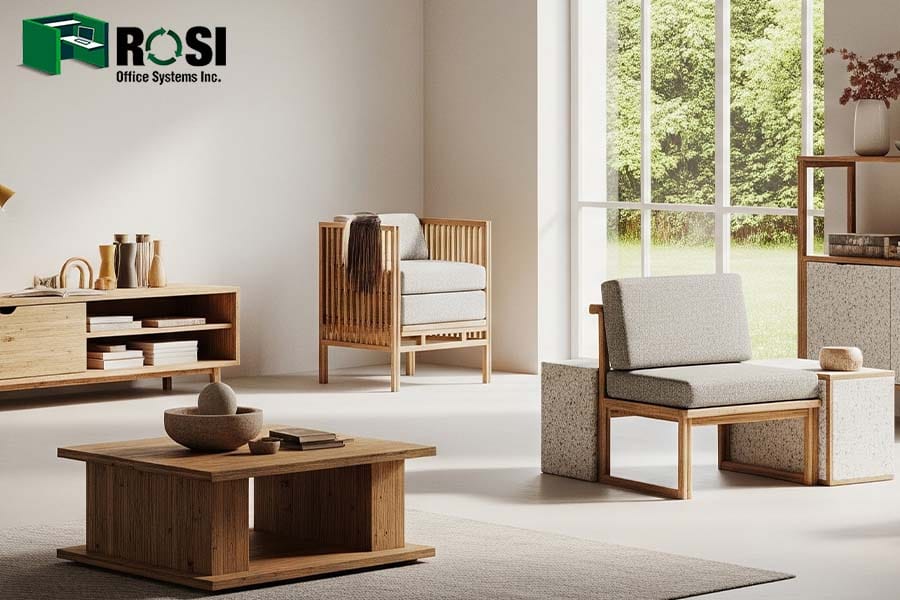
You Might Also Enjoy: Top 10 Office Space Trends You Should Try in 2026
Examples of Biophilic Furniture
Biophilic furniture, by utilizing natural forms, textures, and materials, is not only functional but also brings a sense of peace, authenticity, and connection with nature to the space.
Below are some inspiring examples of biophilic furniture designs.
- Live-Edge Wood Tables: These tables maintain the original shape of the tree trunk, and each piece uniquely tells a story of nature.
- Armchairs woven from rattan or seagrass: These lightweight, renewable materials not only create a warm and natural feel, but their handcrafted textures create a more intimate space.
- Side tables crafted from raw stone or clay: The rough texture and earthy tones of these materials reinforce a sense of grounding and connection to nature.
- Cork stools or accent tables: With features such as lightness, recyclability, antibacterial properties, and soundproofing, this biophilic furniture is ideal for modern and sustainable spaces.
- Desks or shelving units with integrated planters: Designs that allow for growing small plants or succulents inside furniture both add to the beauty of the space and improve air quality.
- Sofas with natural fiber upholstery and wooden frames: A combination of comfort, breathability, and natural beauty that enhances the sense of relaxation in the space.
- Lighting fixtures made from natural materials: These elements are made of bamboo, wood, or recycled glass, which makes the space warm and pleasant by diffusing soft light through natural materials.
Biophilic Furniture Trends for 2026
In 2026, biophilic furniture design will move forward with a smarter, more sustainable, and more humane approach.
Trends in this area not only redefine beauty but also directly respond to health, sustainability, and multi-purpose functions.
- Sustainability as a Standard: These days, the use of recycled and biodegradable materials is accepted as a basic principle in the design of biophilic furniture.
Certifications like FSC for textiles demonstrate brands’ commitment to the environment and consumer health.
- Earthy Tones and Organic Textures: Colors like deep browns, olive greens, earthy, and warm neutrals, combined with layered textures of wood, fabric, stone, and natural fibers, create a rich, earthy environment that brings a sense of nature into the space.
- Curved and Sculptural Forms: Soft, rounded designs inspired by natural forms have replaced sharp, geometric shapes in 2026.
These organic lines inspire a sense of comfort, continuity, and natural flow, and are ideal for calm and inviting spaces.
- Multifunctional and Modular Biophilic Pieces: Biophilic furniture is increasingly being designed to be adaptable.
For example, modular office furniture such as tables that convert into shelves, or benches that have hidden storage space, while still being made of natural materials and maintaining their natural beauty.
- Smart Integration: Smart features like adjustable lighting or climate control will be subtly embedded into biophilic design in 2026.
These technologies create a more comfortable and harmonious experience without conflicting with nature.
- Handcrafted and Artisanal: Greater appreciation for pieces made by local artisans with indigenous materials has led to the creation of unique, detailed, and meaningful furniture that adds authenticity and character to the space.
- Wellness-Centric Spaces: Biophilic furniture has become a staple in the design of restorative personal spaces such as meditation rooms, relaxation corners, and therapy rooms.
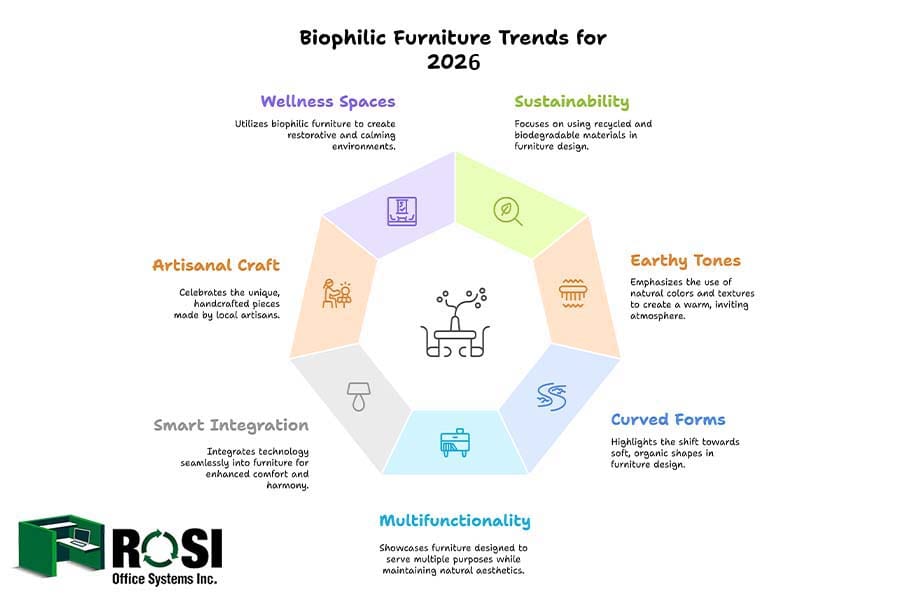
How to Incorporate Biophilic Furniture into Your Space
Integrating biophilic furniture into your living or work space doesn’t require major or costly changes.
With a few simple and gradual choices, nature can be brought into the environment tangibly and harmoniously.
- Start Small: Start with biophilic decor elements like vases with natural branches, scarves and cushions made from natural fibers, or small potted plants on tables and shelves.
These are simple ways to feel the presence of nature.
- Invest in Key Pieces: Choosing an outstanding piece of furniture with a biophilic design can transform the visual identity of the space and create an inspiring focal point.
- Layer Textures: By combining different natural materials such as wooden furniture, linen cushions, and jute rugs, you can add depth, warmth, and sensory diversity to the space and make it look more alive and natural.
- Maximize Natural Light: Arrange furniture to take advantage of daylight and views of the outdoors.
Proximity to windows and views enhances the sense of connection to the outdoors.
- Mix Styles: Biophilic furniture can coordinate with a wide range of interior styles, such as minimalist, boho, or rustic.
Its flexibility allows you to bring nature into your space without destroying its identity.
Conclusion
As one of the main pillars of futuristic design in 2026, biophilic furniture redefines the boundary between the aesthetic beauty of space and functionality.
This type of furniture has become a vital part of modern livable spaces, with a profound impact on physical and mental health, environmental sustainability, and the sensory experience of individuals.
In 2026, biophilic furniture will play a major role in creating environments that are healthier and more sustainable.
By returning to natural materials, organic forms, and the tangible presence of nature in design, this approach responds to people’s inner needs for relaxation, connection, and renewal of energy while respecting nature.
Biophilic furniture is not just a passing trend in 2026, but the starting point of a fundamental shift in the creation of workspaces.
Using this furniture is tantamount to moving towards spaces that are more in harmony with nature, designed for humans, and creating a more sustainable future.
If you, too, would like to reap the benefits of biophilic furniture, think about how you can incorporate it into your living or work space.
Whether through a specific piece or gradual changes in texture, light, or material, you can harmonize the space with nature.
Every small step will be a big move towards an inspiring, peaceful space in harmony with nature!
If you want to know where to buy office furniture to create a biophilic design in your workspace, contact us at ROSI Office Systems Inc.

John Ofield is a recognized expert in the office furniture and office cubicle industry in Houston, TX, with over 40 years of experience. As the founder of ROSI Office Systems, he specializes in furniture space planning, custom cubicle designs, modern office chairs and tables, and high-quality commercial furniture. John’s expertise helps businesses enhance productivity and collaboration. He is also dedicated to mentoring entrepreneurs and redefining workspaces to inspire success.